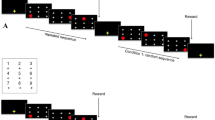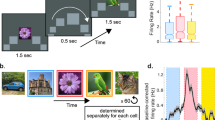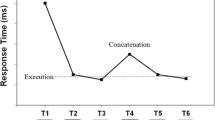Summary
Lashley's suggestion that serial behavior has a dual organization, central facilitation of the entire sequence plus scanning of the individual movements, is taken as the starting point for the construction of a model to illustrate in more detail how the nervous system might work during such behavior.
Two stages in the learning of a sequence are distinguished: 1. immediate reproduction of a presented sample, and 2. reproduction of habitual responses by association, without the necessity of recent access to the original sample. The model is primarily concerned with performances of the first type.
Neurons of a scanning chain, which always fire one another in the same order, acquire temporary connections with the movements to be recalled. The connections fade rapidly with disuse so that the same scanning chain can be used again with different combinations of movements.
The same mechanism will also permit the recall of sequences of words, or other habitual movement complexes, as if they were individual movements. It is assumed that such habitual motor patterns as words are under the control of higher-order cell assemblies which regulate the sequences of movements within the response, and thus substitute for the general scanning mechanism. This leaves the scanner free to form temporary associations with the higher-order cell assemblies for the words.
It is suggested that the scanning mechanism is actuated only by unpredictable inputs so that the elements within a habitual series do not acquire unnecessary connections with the scanning neurons. The arousal system is known to have this characteristic of not being disturbed by the expected, and it seems likely that the two systems are intimately related.
Similar content being viewed by others
Bibliography
Amassian, V. E., and H. J. Waller: Spatiotemporal patterns of activity in individual reticular neurons. In H. H. Jasper, L. D. Proctor, R. S. Knighton, W. C. Noshay and R. T. Costello (eds.), Reticular formation of the brain. Boston: Little & Brown 1958.
Enticknap, L. E.: The decade-counter tube in the psychological laboratory. Amer. J. Psychol. 73, 138–139 (1960).
Granit, R.: Receptors and sensory perception. New Haven: Yale University Press 1950.
Grafstein, Bernice, B. D. Burns and W. Heron: Activity of cortical neurons in response to patterned visual stimuli. In D. B. Tower and J. P. Schadé (eds.), Structure and function of the cerebral cortex. Amsterdam: Elsevier Publ. Co. 1960.
Hebb, D. O.: The organization of behavior. New York: Wiley 1949.
Hubel, D. H.: Cortical unit responses to visual stimuli in nonanesthetized cats. Amer. J. Ophthal. 1958, No 46II, 110–121.
Jasper, H., G. F. Ricci and B. Doane: Patterns of cortical neuronal discharge during conditioned responses in monkeys. In G. E. W. Wolstenholme and Cecilia M. O'Connor (eds.), Neurological basis of behavior. London: Ciba Foundation 1958.
Jung, R.: Neuronal discharge. Electroenceph. clin. Neurophysiol. Suppl. 4, 57–71 (1953);- Coordination of specific and nonspecific afferent impulses at single neurons of the visual cortex. In H. H. Jasper et al. (eds.), Reticular formation of the brain. Boston: Little & Brown 1958.
Kimura, Doreen: Visual and auditory perception after temporal-lobe damage. Unpublished Doctoral Diss. McGill University 1960.
Lashley, K. S.: The problem of serial order. In L. A. Jeffress (edit.), Cerebral mechanisms in behavior. New York: Wiley 1951.
Miller, G. A., E. Galanter and K. H. Pribram: Plans and the structure of behavior. New York: Holt 1960.
Milner, P. M.: Learning in neural systems. In M. C. Yovits and S. Campbell (eds.), Self-organizing systems. Oxford: Pergamon Press 1960.
Mountcastle, V. B.: Modality and topographic properties of single neurons of cat's somatic sensory cortex. J. Neurophysiol. 20, 408–434 (1957).
Sperry, R. W.: Neurology and the mind-brain problem. Amer. Scientist 40, 291–312 (1952).
Sharpless, S., and H. Jasper: Habituation of the arousal reaction. Brain 79, 655–680 (1956).
Tinbergen, N.: The study of instinct. Oxford: Clarendon Press 1951.
Wechsler, D.: The measurement of adult intelligence. Baltimore: Williams & Wilkins 1944.
Author information
Authors and Affiliations
Rights and permissions
About this article
Cite this article
Milner, P.M. A neural mechanism for the immediate recall of sequences. Kybernetik 1, 76–81 (1961). https://doi.org/10.1007/BF00288818
Issue Date:
DOI: https://doi.org/10.1007/BF00288818




